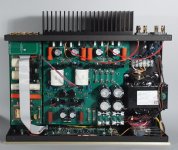- Thread Author
- #1

Conrad-Johnson is pleased to announce the availability of the new conrad-johnson CA150 control amplifier – a power amplifier with level control and source selectors. A control amplifier is identical in function to an integrated amplifier, but without the additional distortions that would be inherent in a superfluous line-stage. Like an integrated amplifier, a control amplifier also eliminates the colorations of preamplifier to amplifier interconnect cables. The CA150 combines the circuitry of our popular MF2275 power amplifier with source selector circuits and a Burr-Brown precision level control.

